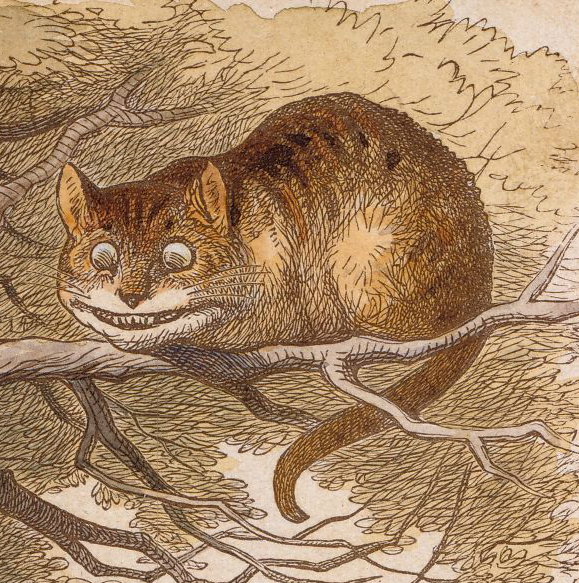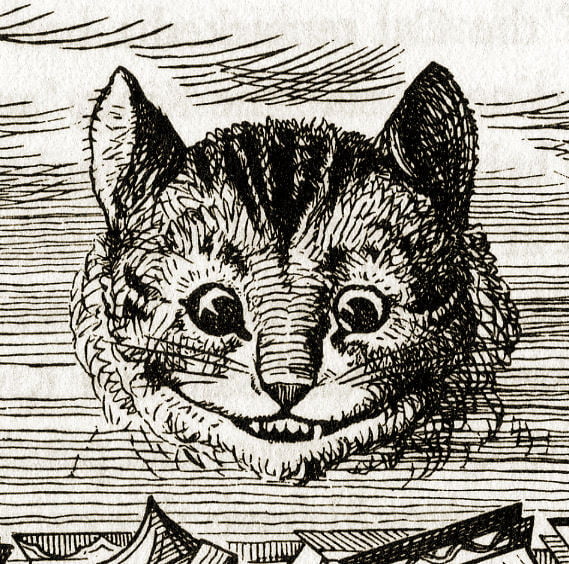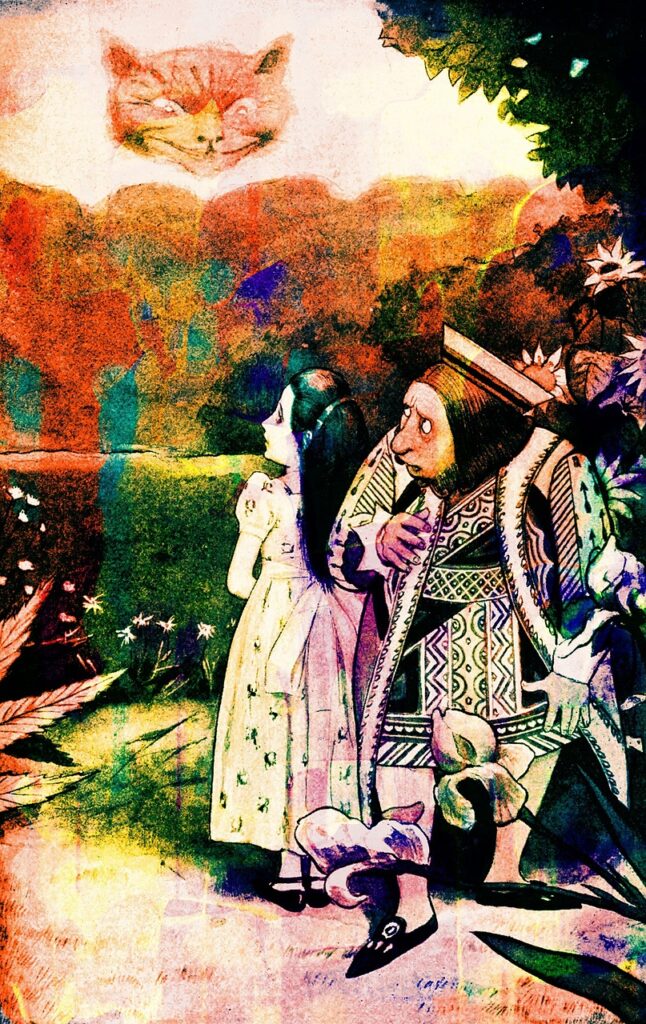The Cheshire Cat

“Most everyone’s mad here”
“You may have noticed that I’m not all there myself”
The Cheshire Cat is a fictional cat popularised by Lewis Carroll in Alice’s Adventures in Wonderland and known for its distinctive mischievous grin. While most often celebrated in Alice-related contexts, the Cheshire Cat predates the 1865 novel and has transcended the context of literature and become enmeshed in popular culture. One of its distinguishing features is that from time to time its body disappears, the last thing visible being its iconic grin.
D&D 5E Epic Monsters: Cheshire Cat
D&D 5E – Epic Monsters: Cheshire Cat | EN World | Dungeons & Dragons | Tabletop Roleplaying Games
“Grinning like a Cheshire Cat” has been a phrase in England for some time before 1865. First off there’s a county in England called Cheshire that’s long been known for its dairy farms, and a happy milk-and-cream-filled cat is a grinning cat! If we’re believing Brewer’s Dictionary, “it has been said that cheese was formerly sold in Cheshire moulded like a cat that looked as though it was grinning,” and the practice of eating started at the tail and ended with its smiling head.
However, public-houses and inns in Cheshire (and the village of Charlton) might have spawned it, being associated with cats for various reasons (either by their name like “The Cat at Charlton” or a degraded lion crest or tiger crest of an associated family). Looking back to the 1788 work by Francis Grose, A Classical Dictionary of the Vulgar Tongue, Second, Corrected, and Enlarged Edition, you can find an entry for Cheshire cat: “He grins like a Cheshire cat; said of any one who shows his teeth and gums in laughing.” Four years later in Jon Wolcot’s Peter Pindar’s Pair of Lyric Epistles again we get another literary reference: “Lo, like a Cheshire cat our court will grin.” A decade before Carrol’s big work comes out, in William Thackeray’s The Newcomes, again we get a third literary reference: “That woman grins like a Cheshire cat.”
In my opinion the most likely source of these references is rooted in the first suggestion and the (apparently widely used) phrase “grinning like a cat that got the cream” and the association with Cheshire County where dairy production in England has been central for a very long, long time. But what about the disappearing part? Hop in that time machine folks because we’re winding it way, way back, all the way to the 11th and 12th century where Cheshire received special borderland laws and notable independence from the crown for centuries. King’s Sheriffs chasing after criminals could not pursue them into Cheshire—which would certainly bring a grin to any thief’s face, and give us some due for this character’s disappearing act. Throw in that ancient languages show that ‘caitiff’ meant ‘cowardly or base villain; mean despicable fellow’, and that ‘cat’ meant ‘sharp fellow’ and it’s starting to congeal.
For everyone not in the United Kingdom, our first introduction to this concept and character came in Lewis Carroll’s Alice’s Adventures in Wonderland. The creature—cheerleader, philosopher, weirdo—stalks after the book’s young lady protagonist, quizzing her in odd ways as it disappears and reappears in different places. Where the novel’s character’s origins lay is murky. During Carroll’s time there was a professor at Oxford named Edward Pusey, known as the Patristic Caternay. Speaking of caternay, Carrol was a mathematician and must have known about the word’s alternate definition: the curve of a horizontally-suspended chain and same shape as a grin. Turning back onto the church again, a curious cat statue on the tower of St. Wilfrid’s Church less than 5 miles from where Lewis was born in Cheshire County (which he would’ve seen plenty with his father, Reverend Charles Dodgson, the Rector of Croft and Archdeacon of omg I’m bored with it already he was way into the church jfc). The final possibility we’re going to consider here is that it’s got to do with a breed of cat known as the British Shorthair that’s said to, when embarrassed, react by putting on a “Cheshire cat smile”.
Cheshire Cat
Tiny fey, chaotic neutral
Armor Class 14
Hit Points 36 (8d4+16)
Speed 40 ft., climb 30 ft.
| STR | DEX | CON | INT | WIS | CHA |
| 3 (–4) | 19 (+4) | 14 (+2) | 15 (+2) | 12 (+1) | 16 (+3) |
Saving Throws Dex +6, Wis +4, Cha +5
Skills Deception +7, Insight +3, Perception +3, Stealth +6
Damage Resistances psychic
Condition Immunities charmed, frightened
Senses darkvision 120 ft., passive Perception 13
Languages English, Sylvan
Challenge 3 (700 XP)
Innate Spellcasting. The Cheshire Cat’s innate spellcasting ability is Charisma (spell save DC 13). The Cheshire Cat can innately cast the following spells, requiring no material components:
At will: misty step, vicious mockery
3/day each: confusion, detect thoughts, hellish rebuke
Keen Smell. The Cheshire Cat has advantage on Wisdom (Perception) checks that rely on smell.
Magic Resistance. The Cheshire Cat has advantage on saving throws against spells and other magical effects.
Staged Invisibility. The Cheshire Cat uses an action to magically turn invisible, but it does so gradually. Before the end of its turn the Cheshire Cat’s body and any equipment it is carrying or wearing disappear, giving it +2 to AC. At the start of its next turn everything but the Cheshire Cat’s grin disappears, increasing its bonus to AC to +5. Finally at the start of the following turn the Cheshire Cat is completely invisible (no AC bonus). When it is fully invisible, the Cheshire Cat’s invisibility lasts until it attacks or its concentration ends (as if concentrating on a spell).
ACTIONS
Claws. Melee Weapon Attack: +0 to hit, reach 5 ft., one target. Hit: 1 slashing damage.
The Cheshire Cat

Originally Posted by Amiel of the Giant in the Playground Forums.
Lewis Carroll’s character
The Cheshire Cat is now largely identified with the character of the same name in Lewis Carroll’s novel Alice’s Adventures in Wonderland. Alice first encounters the Cheshire Cat at the Duchess’s house in her kitchen, and later on the branches of a tree, where it appears and disappears at will, and engages Alice in amusing but sometimes perplexing conversation. The cat sometimes raises philosophical points that annoy or baffle Alice; but appears to cheer her when it appears suddenly at the Queen of Hearts’ croquet field; and when sentenced to death, baffles everyone by having made its head appear without its body, sparking a debate between the executioner and the King and Queen of Hearts about whether a disembodied head can indeed be beheaded. At one point, the cat disappears gradually until nothing is left but its grin, prompting Alice to remark that “she has often seen a cat without a grin but never a grin without a cat”.
| The Cheshire Cat | |
| Medium fey | |
| Hit Dice | 15d6+45 (97 hp) |
| Initiative | +12 |
| Speed | 50 ft., Fly 100 ft. (good) |
| Armor Class | 41 (+8 Dexterity, +23 natural), touch 18, flat-footed 33 |
| Base Attack/Grapple | +7/+9 |
| Attack | Claw+17 melee (1d8+2) |
| Full Attack | 2 claws +17 melee (1d8+2) and bite +12 melee (1d6+1) |
| Space/Reach | 5 ft./5 ft. |
| Special Attacks | Spell-like abilities |
| Special Qualities | Change shape, damage reduction 20/cold iron, dweller upon the crossroads, Darkvision 120 ft., gleefully mad, grin, Low-Light Vision, immunity to acid, cold, fire, electricity, mind-affecting effects, poison and petrification, planeshift, regeneration 10, see in darkness, Spell Resistance 30, tongues, uncanny dodge |
| Saves | Fort +14, Ref +19, Will +19 |
| Abilities | Strength 14, Dexterity 27, Constitution 16, Intelligence 27, Wisdom 27, Charisma 27 |
| Skills | Yes |
| Feats | Improved Initiative, Iron Will, lightning reflexes, Persuasive, Power Attack, StealthyB, Weapon Finesse |
| Environment | Any |
| Organization | Solitary |
| Challenge Rating | 15 |
| Treasure | No coins; double goods; standard items |
| Alignment | Always chaotic neutral |

Change Shape (Su): The Cheshire Cat can assume the form of any Small or Medium humanoid, animal or magical beast.
Dweller Upon The Crossroads (Ex): Locked inside the form of the Cheshire Cat is a nexus of portals and intertwining interdimensional pathways. The Cat has mastered these crossroads to an unprecedented degree. This confers the following abilities.
The Cheshire Cat can greater teleport as a swift action (caster level 15th).
The Cheshire Cat is considered incorporeal (as the subtype) and invisible if it chooses to appear as so. A creature must succeed on a DC 25 Will save or be fascinated (as the status effect). The Cat may manifest corporeality and visibility as a standard action every round. The save-DC is Charisma-based.
Gleefully Mad (Ex): The Cheshire Cat has secured and sequestered his thoughts behind a unique abjuration. A creature must succeed on three consecutive DC 25 Will saves to pierce the fog surrounding the Cat’s thoughts or be affected by hideous laughter.
The Cat is, for all intents and purposes, under a continual mindblank spell.
Grin (Ex): The Cheshire Cat is under the constant effects of an Enthrall spell. This is a non-magical ability and cannot be dispelled. Every 1d3 rounds, the Cat can also make a suggestion; the Cat needn’t verbalise the intent of the suggestion, creatures must however see the Cat grin.
3/day, the Cheshire Cat can effect mass charm monster through his grin.
Skills: The Cheshire Cat has a +8 racial bonus on Climb, Hide, Jump, Move Silently, and Balance checks.
Spell-Like Abilities: At will – air walk, dream, fog cloud, Greater Scrying, invisibility, locate creature, mislead.
3/day – false vision, haste, mind fog, mirage arcana, permanent image, programmed image, project image, slow.
Caster level 15th. The save-DCs are Charisma-based.

 Buy me a coffee
Buy me a coffee